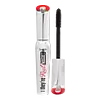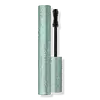Benefit Cosmetics They're Real! Magnet Extreme Lengthening Mascara Versus Too Faced Better Than Sex Waterproof Mascara
What's inside
What's inside
 Key Ingredients
Key Ingredients

 Benefits
Benefits

 Concerns
Concerns

 Ingredients Side-by-side
Ingredients Side-by-side

Water
Skin ConditioningCera Alba
EmollientParaffin
PerfumingPolybutene
Vp/Eicosene Copolymer
Glyceryl Stearate
EmollientAcrylates Copolymer
Copernicia Cerifera Wax
Steareth-21
CleansingPalmitic Acid
EmollientPvp
Emulsion StabilisingStearic Acid
CleansingSilica
AbrasivePentylene Glycol
Skin ConditioningPhenoxyethanol
PreservativeSteareth-2
EmulsifyingAminomethyl Propanediol
BufferingCaprylyl Glycol
EmollientPanthenol
Skin ConditioningHydroxyethylcellulose
Emulsion StabilisingAluminum Hydroxide
EmollientTocopheryl Acetate
AntioxidantDisodium Phosphate
BufferingSodium Phosphate
BufferingPolysorbate 60
EmulsifyingCI 19140
Cosmetic ColorantCI 42090
Cosmetic ColorantCI 77007
Cosmetic ColorantCI 77163
Cosmetic ColorantCI 77288
Cosmetic ColorantCI 77289
Cosmetic ColorantCI 77491
Cosmetic ColorantCI 77492
Cosmetic ColorantCI 77499
Cosmetic ColorantCI 77510
Cosmetic ColorantCI 77742
Cosmetic ColorantCI 77891
Cosmetic ColorantWater, Cera Alba, Paraffin, Polybutene, Vp/Eicosene Copolymer, Glyceryl Stearate, Acrylates Copolymer, Copernicia Cerifera Wax, Steareth-21, Palmitic Acid, Pvp, Stearic Acid, Silica, Pentylene Glycol, Phenoxyethanol, Steareth-2, Aminomethyl Propanediol, Caprylyl Glycol, Panthenol, Hydroxyethylcellulose, Aluminum Hydroxide, Tocopheryl Acetate, Disodium Phosphate, Sodium Phosphate, Polysorbate 60, CI 19140, CI 42090, CI 77007, CI 77163, CI 77288, CI 77289, CI 77491, CI 77492, CI 77499, CI 77510, CI 77742, CI 77891
Isododecane
EmollientParaffin
PerfumingVp/Eicosene Copolymer
Beeswax
Emulsion StabilisingDisteardimonium Hectorite
StabilisingPentaerythrityl Hydrogenated Rosinate
Cyclopentasiloxane
EmollientTalc
AbrasiveCopernicia Cerifera Wax
Polybutene
Water
Skin ConditioningSilica
AbrasiveCaprylyl Glycol
EmollientPolyquaternium-7
Plukenetia Volubilis Seed Oil
EmollientTrimethylpentanediol/Adipic Acid/Glycerin Crosspolymer
Skin ConditioningVp/Hexadecene Copolymer
Caprylic/Capric Triglyceride
MaskingOctyldodecanol
EmollientHoya Lacunosa Flower Extract
Skin ConditioningPhenoxyethanol
PreservativeSodium Benzoate
MaskingCI 77499
Cosmetic ColorantIsododecane, Paraffin, Vp/Eicosene Copolymer, Beeswax, Disteardimonium Hectorite, Pentaerythrityl Hydrogenated Rosinate, Cyclopentasiloxane, Talc, Copernicia Cerifera Wax, Polybutene, Water, Silica, Caprylyl Glycol, Polyquaternium-7, Plukenetia Volubilis Seed Oil, Trimethylpentanediol/Adipic Acid/Glycerin Crosspolymer, Vp/Hexadecene Copolymer, Caprylic/Capric Triglyceride, Octyldodecanol, Hoya Lacunosa Flower Extract, Phenoxyethanol, Sodium Benzoate, CI 77499
 Reviews
Reviews

Ingredients Explained
These ingredients are found in both products.
Ingredients higher up in an ingredient list are typically present in a larger amount.
Caprylyl Glycol is a humectant and emollient, meaning it attracts and preserves moisture.
It is a common ingredient in many products, especially those designed to hydrate skin. The primary benefits are retaining moisture, skin softening, and promoting a healthy skin barrier.
Though Caprylyl Glycol is an alcohol derived from fatty acids, it is not the kind that can dry out skin.
This ingredient is also used as a preservative to extend the life of products. It has slight antimicrobial properties.
Learn more about Caprylyl GlycolCi 77499 is also hydrated iron III oxide. It is created from mixing red and black iron oxides. This helps give shades of darkness to a product.
Iron III oxides are classified as inorganic chemicals for coloring.
Copernicia Cerifera Wax comes from a palm tree native to Brazil; another name for this ingredient is Carnauba Wax.
This ingredient is used to thicken texture and also leaves behind a film when applied.
Fun fact: This wax has the highest melting point of all natural waxes and low solubility.
Learn more about Copernicia Cerifera WaxParaffin is a solid created from petroleum. The term 'paraffin' can also refer to either
petroleum jelly or mineral oil.
It has natural occlusive properties which can worsen oily skin. Due to its petrolatum base, this ingredient is not fungal-acne safe.
Phenoxyethanol is a preservative that has germicide, antimicrobial, and aromatic properties. Studies show that phenoxyethanol can prevent microbial growth. By itself, it has a scent that is similar to that of a rose.
It's often used in formulations along with Caprylyl Glycol to preserve the shelf life of products.
Polybutene is used to help control the viscosity of a product. This just means it helps adjusts the texture.
It is a polymer and does not get absorbed into the skin due to its large size.
Studies found this ingredient did not irritate skin in concentrations below 15%.
Learn more about PolybuteneSilica, also known as silicon dioxide, is a naturally occurring mineral. It is used as a fine, spherical, and porous powder in cosmetics.
Though it has exfoliant properties, the function of silica varies depending on the product.
The unique structure of silica enhances the spreadability and adds smoothness, making it a great texture enhancer.
It is also used as an active carrier, emulsifier, and mattifier due to its ability to absorb excess oil.
In some products, tiny microneedles called spicules are made from silica or hydrolyzed sponge. When you rub them in, they lightly polish away dead skin layers and enhance the penetration of active ingredients.
Learn more about SilicaWe don't have a description for Vp/Eicosene Copolymer yet.
Water. It's the most common cosmetic ingredient of all. You'll usually see it at the top of ingredient lists, meaning that it makes up the largest part of the product.
So why is it so popular? Water most often acts as a solvent - this means that it helps dissolve other ingredients into the formulation.
You'll also recognize water as that liquid we all need to stay alive. If you see this, drink a glass of water. Stay hydrated!
Learn more about Water